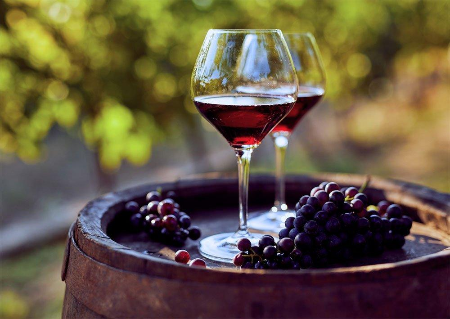No, on this occasion (sadly), we’re not talking about the joyful 80’s hit from UB40, but instead one of the world’s greatest exports and arguably one of life’s finest discoveries…Red Wine.
Now for those of us living under a rock since, well, around 6000BC when it is said to have first been acknowledged we’re going to start with a very simple breakdown of the origin of this delightful alcoholic beverage.
Red Wine is an incredibly popular type of wine which gains its deep & luxurious red hue naturally during fermentation from the colour of the dark (black) grapes.
The colour of the wine is often red, purple, or opaque as a result of this process. So with all of the formalities out of the way, join us as we delve a little deeper into the wonderful world of Red Wine.

Can red wine be chilled?
Short answer and a somewhat unpopular opinion, yes, you can indeed chill red wine. There is a common misconception about red wine however, as many individuals believe that red wine is better served at room temperature. However, this is neither erroneous nor 100% accurate. Red wine types are the key factor.
Red wine is often served slightly warmer than most white wines. Some red wines are actually thought to taste better when chilled.
Red wines such as Pinot Noir, Tempranillo, Angel, Shiraz, Cabernet Sauvignon, and Cabernet Franc, among others, should be chilled for 45-70 minutes before serving.
Other red wines should be served between 12–17 °C, which is considered the “perfect” temperature and likely where the popular belief around room temperature being the ‘only’ way to enjoy red wine, was derived.
Generally speaking, the cooler you serve wine, the less you detect its acidity and bitterness.
The flavour of red wines, by their very nature often yield a rather bitter aftertaste and so may be impacted significantly by higher temperatures. It could make the flavours hazy and soupy.
Even for full-bodied reds like Cabernet Sauvignon or Shiraz, it's critical to keep the wine from getting too warm before serving.
What is a good red wine that's not bitter?
Now it would be pretty unfair to judge a wine's bitterness based simply on what you may have read or heard. Everyone's tolerance for bitterness is different and the term ‘bitterness’, in the world of wine, refers to a lack of perception of sugar or fruit flavours.
Tannins are a key term for describing the dryness or bitterness of wine. Grape skins, seeds, and the infrequently used stems all contain tannins, so depending on the grape variety, tannin content varies from grape to grape and thus bottle to bottle.
Red wines often contain more tannins than other types, since they are in contact with the grape for a longer period of time.
The wooden barrels used to age most wines may also contain tannins and therefore also have an impact on the flavour and indeed the bitterness of the wine.
In the case of oak, the wine is said to pick up vanilla characteristics as a result of the wood tannins being absorbed into it.
The flavour of tannins is similar to that of a cup of strong black tea without any added sugar. Although it has a bitter flavour, when you drink high tannin red wine, the bitterness is enjoyable and often what attracts people to a “good” bottle of red.
Red wine may be bitter for a variety of reasons, not only tannins. The inherent sugar in the grapes, manually added sugar, and the wine's natural acidity all play a significant part in determining whether or not the wine will be considered bitter.
The bitterness of the wine will be more noticeable if the wine has a high acid content and therefore is likely to enhance or hinder its flavour profile, based on individual opinion.
Depending on the level of tannin or bitterness, red wine may be categorised into two key categories.
- Bitter red wines (High tannin red wines)
- Sweeter Red Wine (Low tannin red wines)
Bitter red wines
As we’ve established above, the majority of red wine is bitter; some wines are less bitter than others. Many people are fond of bitter red wine and often use this characteristic to determine how they pair it with certain food groups. Here are several wines that are bitter:
- Bordeaux
- Merlot
- Tuscan
- Cabernet Sauvignon
- Shiraz
- Nebbiolo
Less bitter red wines
It goes without saying that red wines with less bitterness are often sweeter than other wines. Subject to personal preference or the dish you’re looking to enjoy these with you may wish to choose one of these wines, that are considered less bitter:
- Tempranillo
- Pinot Noir
- German Riesling
- Gamay

What is the healthiest red wine?
Now the term ‘healthy’ in this particular instance refers simply to some of the suggested health benefits associated with the ingredients in red wine, rather than suggesting that an alcoholic beverage should ever be considered ‘healthy’ if not enjoyed as part of a healthy balanced diet.
However, according to many journals, drinking wine with such considered limitations, can be far from harmful to the human body.
Instead it is supposed that red wine has been linked to a variety of health benefits, including longevity, lower blood pressure, and heart health, among others.
Red wine is especially high in phytochemicals, including resveratrol and quercetin.
These powerful antioxidants have been linked to an array of health benefits, including arthritis relief, and a reduced risk of heart disease alongside other cardiovascular conditions.
Moreover, low sugar, low alcohol content, and high antioxidant content make wine healthier in general.
Here are the top 5 red wines for ‘health’:
1. Pinot Noir
Pinot Noir has a high concentration of resveratrol and is the healthiest red wine. A full-bodied, dry red wine with low sugar, low calories, and medium alcohol concentration is produced from the Pinot Noir vine.
2. Malbec
Malbec grapes have thick skins and are rich in anti-oxidants including quercetin and resveratrol. Malbec wine has twice as many antioxidants as Merlot and four times as much as Cabernet Sauvignon.
3. Merlot
Merlot is another excellent wine. It has also been supposed to contain high quantities of resveratrol, so you still receive the heart-healthy advantages and get that rich full-bodied flavour that so many sommeliers and wine lovers have come to adore.
4. Cabernet Sauvignon
Cabernet Sauvignon is the most extensively cultivated red wine grape variety in the world. It has a substance that kills certain types of bacteria that cause cavities and prevents damage to the enamel of the teeth.
Similar heart-health advantages have been found in this full-bodied red wine, with flavours of dark fruit and baking spice.
5. Petite Sirah
Due to its high tannin content, Petite Sirah is a robust, gorgeous red wine with a tinge of bitterness. Resveratrol and other anti-oxidants are also found in the wine's polyphenols.
It has the potential to prevent cancer, cardiovascular disease, diabetes, and neurological disorders. Although there is a lack of sufficient research and reliable sources to say so.
What qualifies as a concentrated red wine?
Concentrated wine has a depth and richness of fruit that appeals to and sparks the curiosity of drinkers around the world. Higher quantities of phenolic components, such as tannin, and colourants like anthocyanin are found in concentrated red wines.
In most cases, the grape skins and seeds used provide the bulk of the flavour and colour components. All of these factors contribute to the powerful flavour, “weight” on the tongue, and rich feeling associated with more “concentrated” red wines.
So whether you’re a newbie to the red wine scene or you’re a seasoned wine veteran, hopefully this rundown of all things Red Wine has given you a little more to sip & savour.
In conclusion
So hopefully the above has given you a better insight into red wine. When it comes to red wine, we have a fantastic selection at the Wine Caverns and we pride ourselves on offering it online at a reasonable price. Some additional little pointers to consider when looking for a nice bottle of Red Wine, be sure to check out the description on our individual wine product pages, one of our teams favourites is the Chateau De Berne La Grande Cuvee which can be ordered as a Magnum. Be sure to look at the ABV as some Reds can be high And finally, if you see a vintage year on the label, that means the grapes were all harvested in that year - which is usually a good thing.

















